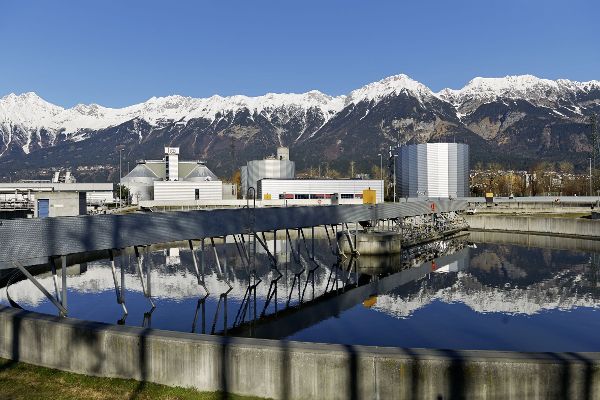Wastewater in Austria

Apart from the wastewater from municipal and industrial wastewater treatment facilities, also polluted precipitation water is considered wastewater.
In the sewage system wastewater is collected. In sewage treatment plants it is treated and purified in a way that it can subsequently be introduced into a water body (= receiving water). Wastewater treatment and purification serve the sustainable and resource-saving way of dealing with water. Purified water can be channelled back into the natural water cycle.
In Austria, with its abundance of water, about 3% (i.e. approx. 2.5 km3/year) of the total amount of freshwater available (available water resources) is extracted and used. However, not the entire amount extracted becomes wastewater. For example, part of it is used for irrigation in agriculture. The portion which has been polluted is channelled back into the water cycle after purification in municipal and industrial wastewater treatment facilities.
Composition and volume of wastewater depend on many different factors. Wastewater from households, for example, is usually contaminated with pollutants different from industrial wastewater.
According to the Water Act (WRG 1959 as applicable) a license of the competent authority is required for the discharge of wastewater into waters.
The discharge of wastewater has impacts on our waters! It is therefore important to remove nutrients (nitrogen, phosphorus) and other, partly hazardous chemical substances from the wastewater before it is introduced into the receiving water body.
Pollution ceilings set forth in specific emission ordinances have to be complied with. They indicate which quantities of substances may be released into the waters after wastewater purification.
On international level, Austria is a pioneer with respect to the quality of wastewater purification.
Wastewater disposal and wastewater treatment – precautionary principle
Wastewater disposal is a key issue of the Austrian water protection policy. We rely on the precautionary principle.
According to this principle wastewater has to be purified in line with the state of the art. In this way subsequent cleaning up of contaminated waters is to be avoided.
Furthermore, the ‘combined approach’, which integrates two different views, is practised. On the one hand, the status of a receiving water body is investigated. Depending on the result, requirements for the required quality of (purified) wastewater to be introduced are deduced (water quality objective approach). In addition, there are also uniform requirements for the introduction of (purified) wastewater, irrespective of the properties of the receiving water body emission standard approach).
If the introduction of wastewater into a water body is authorised, in a first step emission limits which can be achieved using the treatment methods and comply with the state of the art are defined. In the following step it is examined whether the quality objectives can definitely be achieved upon compliance with these emission standards (air pollution). In case the application of the state of the art is not sufficient to reach the quality goals in the water body concerned, additional treatment steps in the wastewater purification plant or preventive measures have to be carried out.
Since the 1990ies contaminations of groundwater and surface waters have been considerably reduced in Austria. The major reasons for this are:
- Emission limits have been set for municipal wastewater purification facilities, industrial and commercial enterprises; this means that only limited amounts of pollutants may be released into the environment.
- As early as in the planning process for industrial plants attention is paid to the protection of water resources.
- Sewer networks and wastewater treatment plants have been further developed and maintained.
- There are measures for the remediation of historic contaminated sites. The treatment and disposal of waste are subject to stringent rules.
- In agriculture, an environmental programme is implemented which promotes an environmentally compatible, extensive agriculture which protects the natural areas for living. For example, the use of fertilisers is to be reduced.
- Wastewater is channelled back into the water cycle only after mechanical and biological treatment, which includes also the reduction of nutrients.
Statutory regulations
In Austria wastewater disposal is basically regulated by the Water Act (WRG 1959 as applicable) and numerous supplementary ordinances (e.g. the Wastewater Emission Ordinances). At the European level above all the Urban Waste Water Treatment Directive (91/271/EEC), the Hazardous Substances Directive (2006/11/EC), die IE (Industrial Emissions) Directive (2010/75/EU) as well as the Water Framework Directive (2000/60/EC) are of relevance.
Subsidies in residential water management
The Austrian public sector, that is, the Federal government and the Federal Provinces, has for decades subsidised municipal infrastructure measures in the water and wastewater sector. The subsidisation of residential water management for investments in water supply and wastewater disposal has particularly benefited the development of the canal network and wastewater treatment plants in recent years.
The 1379 residential water management projects subsidised in 2018 caused investments of about 483 million Euros; total subsidies amounted to slightly below 86 million Euros. Within the range of wastewater management, this amount helped build 335 km of channel, connect 5,700 objects to sewer systems and reorganise 122 km channel. Today’s excellent standard of wastewater purification is due to the extension of the public sewerage system, the use of rainwater, and wastewater purification facilities at the highest technical stage.